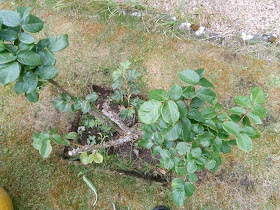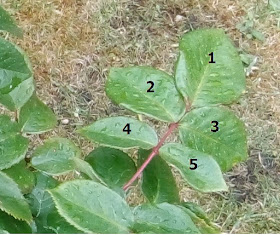Every winter, in the UK, we have so much rain that our gardens turn to mud and we seriously consider developing webbed feet. And yet, nearly every year, we have hosepipe bans to contend with. We're not quite there yet, but on what is supposed to be the hottest day of the year so far, I thought it might be timely to talk about hosepipe bans now.
So what does a hosepipe ban mean to gardeners?
Annoyingly, gardeners don't generally waste water: it's non-gardener types who put the sprinkler on the lawn who give all of us a bad name.
Sprinklers, along with washing the car and filling the pool - or, in these increasingly affluent, "don't talk to me about poverty, how much do you spend getting those horrible fake fingernails/eyebrows done, and why don't you just put the kettle on and make your own coffee instead of paying £3.50 for a single cup of the stuff in some pretentious shop" times, filling the hot tub - where was I? Sorry, got into a it of a rant there, I do apologise.
Sprinklers! That's where I was: sprinklers, along with washing the car, and filling the pool/hot tub, are the biggest wasters of water.
But we gardeners get the blame, and have the finger of shame wagged at us, as soon as there is any sign of a water shortage.
It's so unfair!
However, there are things we can do, and steps we can take, to preserve our gardens and our plants, without having nosy neighbours reporting us to the Water Police.
To start with, if you read the small print of the hosepipe ban - and not just the screaming headlines - there is usually a list of what you are not allowed to do, and what the exemptions are, and it's well worth reading this carefully.
Firstly, all hosepipe bans refer to hoses fitted to mains water
taps: if you collect rainwater in butts or tanks, you can use that water
via a hosepipe, as this is “gravity fed” rather than mains pressure.
Here's one I built some years back, for a Client: the water butt is raised up on a pile of old bricks, and is there to catch water for watering the leaf mold pens, which are to the right and to the left - you can just see the corner posts and the chicken wire, of which they are made.
At first I used to water the leaf mold using a watering can, but it was slow work: so I fitted a short length of old hose to the water butt's tap, which allowed me ....
.... to take the hose round and into the leaf mold pens.
As you can see from this photo - right - the water does not gush out, the way it does from a mains tap, but there's a good flow of water nonetheless, and I can set it going, then leave it for 15 or 20 minutes, while I go and do something else in that area of the garden.
As long as the end of the hosepipe is below the level of the water in the water butt, it will continue to flow gently out. And it's free water!
This is all well and good if your water butts are close to where you need the water, and of course, they usually are not: almost by definition, the water butts are beside the buildings, where the gutters and downpipes live.
But if your garden slopes away from the house, even by a small amount, you can transfer water from water butts up at the house, to a water butt down in the garden, by simply putting a length of hosepipe on the outlet tap of the "house" butt and leading it out to the "garden" butt. It might not fill to the top, of course, but at least you can move some of that free water down to a more convenient location.
Another cunning plan to make watering from the butts easier, is to run a length of hose out to where you need the water, and put a squirty nozzle on the end of it: then take two watering cans, and allow the water to fill one, while you are emptying the other onto the plants.
Like this - left.
Because the water is not at mains pressure, it takes some time to fill the watering can. By alternating between the two can, you don't waste time standing there waiting for it to fill: you can be using one, while the other one fills.
This also means you don't have to keep trogging back and forth to the house to refill the watering can.
Grey Water: this is water that's been used, but is too good to waste down the sewers. It's water from baths, showers, washing machines: and if you save your bathwater and use a hosepipe (usually with a pump or a syphon) to move the grey water out to the butt or garden, that is fine: but remember there are a couple of drawback to using grey water, and it does need a bit of forethought, and a bit of management.
Firstly, don't even try to collect grey water if you don't use plant-based, "eco" detergents.
Secondly, it needs to "sit" for a day or so before you use it, to give micro-organisms a chance to digest the unwanted chemicals in the water, and to allow contaminants to settle to the bottom. If you generate a lot of grey water, you might need to look into filtering systems, but the easy way is to have a dedicated water butt - or two, or three! - for the grey water. So you can fill one butt, over a few days, then leave it to settle for a day while you start to fill the next one. Having three butts would be the truly efficient way to do it: one being filled, one settling for a day, and one with "settled" water, being used.
And clear labelling, so you know which is which!
Complicated, huh?
Thirdly, it shouldn't be allowed to "sit" for too long, otherwise it will smell! So you need to either use it within a couple of days, or you will have to let it out, down the drain. This seems like a shame, but it's better to do this, than to have stinky water sitting around the place.
Fourthly, don't put it directly onto the plants: it's better to put it to one side of the plants, so that the micro-organisms in the soil can continue to work on breaking down those unwanted components. You can sink plastic pots into the soil around the plants, then pour the grey water into the pots, rather than onto the surface of the water. This also helps your plants/veg to develop good root systems, as they are having to go deeper to get the water, rather than having it poured on the surface only.
Fifthly (still not sure if that is a real word...) never run your grey water through your normal hose pipes, or through an irrigation system. Even after it has been sitting for a day, it will still be "contaminated" with meat and dairy debris from washing up dishes, along with bacteria from bathrooms and washing machines - so you don't want those items sitting around in your hoses, nor do you want the particles clogging up your irrigation system.
Talking of irrigation systems, hosepipe bans usually specify that although hoses are banned, irrigation systems are not: the crux point is that irrigation systems must drip the water onto the soil, not spray it or mist it around.
So if you have an irrigation system with a combination of drippers and sprayers, turn off the sprayers (or replace them with drippers for the duration) and you will be fine.
Most hosepipe bans are gradual: they start with banning sprinklers and using a hose to water, but allow us to fill up water butts with the hose, and usually we are allowed to water pots with a hose. But as the water shortage bites, these privileges will be taken away. So it's best to keep checking the website for updates, and it's often worth having a gentle "moan" about it to your neighbours, to make it plain to them that you have checked the rules of a current ban, and are not breaking them!
Bizarrely, there is often an exception for Blue Badge holders: that person (and no other) is allowed to water with a hose. But don't think this means that you can hire a local Blue Badge holder to come and water your garden for you! They are only allowed to water their own garden. And as the shortage continues, the restrictions will change to say that they are only allowed to use a hose if they live alone, on the grounds that if they have a partner/lodger/child living in the same house, then that person can jolly well get out there with the watering can.
As you can see, there are a few things we can do, even in the face of a hosepipe ban, and I hope that this article has given you some ideas!
Did you enjoy this article? Did you find it useful? Would you like me to answer your own, personal, gardening question? Become a Patron - just click here - and support me! Or use the Donate button for a one-off donation. If just 10% of my visitors gave me a pound a month, I'd be able to spend a lot more time answering all the questions!!

























